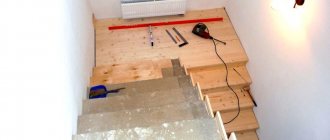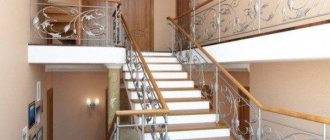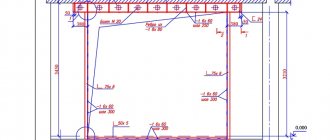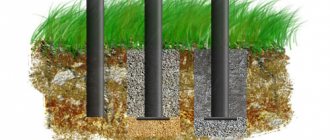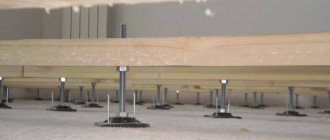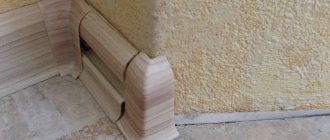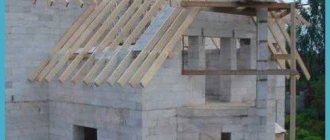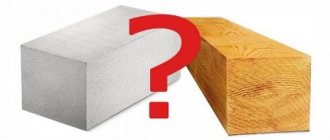Nowadays, wood is often used to create all kinds of structures. In most cases, profiled timber is used, which is well suited as a building material for the construction of houses and other buildings.
Wooden dowels began to be used in order to ensure reliability and strength when connecting building elements. Thus, the structure receives the necessary rigidity, and the likelihood of wood deformation fades into the background. In addition, there will be the possibility of normal shrinkage of the house. Correct installation will make it possible to combine all the elements without losing the required structural properties at home.
Wooden dowels for building a house made of timber Source es.decorexpro.com
Direct purpose of dowels
Dowels are peculiar pins, the installation of which is carried out perpendicular to the axis of the elements. They are used to connect adjacent crowns. The main task of timber dowels is to prevent the elements from moving. This is due to the fact that even dry elements of a wooden frame can be deformed during operation, which is caused by various factors, for example, humidity. The use of this component for fastening does not allow the possibility of wood deformation, because they tightly connect the crowns of the frame with each other.
You can hear many opinions that the dowel serves to tie the frame, but such a judgment is erroneous. This component is designed to ensure that when the timber shrinks and dries, it does not lose its original position, so that the structure of the building does not move.
Features of choosing fasteners
The main criterion for choosing a dowel for concrete is the ability of the fixing element to withstand the expected load. According to experts, for a small-sized and lightweight structure, such as a bookshelf, a screw 70 mm long is suitable. To secure a window frame or door in the opening, you will need longer dowels. Thus, a structure weighing a total of about 100 kg requires the use of screws whose length is at least 150 mm.
An important point when choosing a fastener is the step with which the element is mounted in the general installation system of one object. The distance between the screws should be about 70-100 mm. This distance is reduced or increased, depending on the structural features of the object connected to the concrete base.
When choosing fasteners for concrete, be sure to take into account operating conditions. It’s one thing to use a dowel in a room with a high level of humidity (bathroom, sanitary unit), and another thing to use in a room with dry air, so special attention is paid to the protective coating of the fasteners.
Advantages and disadvantages of fastening with wooden dowels
“Nagel” translated from German means “nail”. It has the form of a pin, which is made from a wooden base. This building element comes in two main shapes: square and round.
With the help of a dowel, the possibility of beam displacement is eliminated, due to which all elements of the construction are constantly kept at the same level.
Operating principle of dowels Source drevo78.ru
See also: Catalog of timber house projects presented at the Low-Rise Country exhibition.
The most important thing is that this fastening element has a smooth surface, because otherwise, cracks may appear in the wall. Among the advantages that open up when using dowels in the construction of wooden houses, we note:
- Corrosion is not a problem for them;
- Do not deform when temperature changes;
- During the assembly of structures, dowels do not interfere with the shrinkage of the walls.
This fastening dries out along with the walls, which is very important.
As for the negative aspects of such “nails”, they are absent. In the case where the decision was made to build a house from timber, the choice of this type of fastening will be the most ideal. There is only one caveat - performing work using dowels will take longer and will be more expensive than using conventional metal nails.
Classification of dowels for concrete
The concrete screw or dowel is available in several versions. Each type of fastener differs in the metal used for manufacturing, the shape of the head, the design of the threaded part, the type of coating and the price.
Metal fabrication
A dowel or screw for concrete is created from the following materials:
- stainless steel - steel with alloying elements;
- brass is an alloy containing zinc and copper;
- Carbon steel is a metal made by combining iron with carbon.
A self-tapping screw for concrete made of carbon metal is the most common type of dowel. This type of steel allows you to create fasteners that do not deform even when screwed into a solid concrete base.
Head shape
Steel dowels are available with countersunk and protruding heads. Hardware caps can have the following design:
- conical shape with a slot for a cross-shaped tool;
- hook or loop;
- a threaded rod for a nut to secure the part being fastened;
- hexagon of regular shape or elongated with internal thread (both options are tightened with open-end wrenches);
- in the shape of a conical head with a slot in the form of a six-pointed star.
The type of cap affects the method of mounting the dowel. Most types of specialty screws can be installed without first preparing the hole. The exception is self-tapping screws with a hook or pin. For them, you need to prepare a hole in advance and install a plastic dowel.
Thread design
Steel self-tapping screws for brick and concrete, depending on the design of the threaded part, are available in the following designs:
- Multifunctional fasteners with medium thread, diameter up to 6 mm and maximum length 20 cm. These are universal self-tapping screws for concrete without dowels. To use them, it is not always necessary to pre-prepare the hole. If necessary, they can be used together with dowels.
- Fasteners with herringbone threads, with a maximum diameter of 8 mm and a length of no more than 20 mm. Dowels are used only in conjunction with dowels. Therefore, it is first necessary to prepare a hole in a solid base. If there are voids in the concrete, an impact dowel with a length no less than a dowel is used.
- Variable types of fasteners with notches are hardware from 7 to 20 cm long with an intermittent thread with a diameter of 7.5 mm. Before using the dowel, you must first prepare a hole with a smaller cross-section than the same size for the fastener. In this case, the depth of the channel in a solid base must be 1–1.5 cm greater.
In Russia, a variable type of hardware with notches is more often used. Builders also call it a turbo screw. Typically, fasteners with a countersunk head are used, which is tightened with a Torx socket. The smallest pull-out load of this dowel is 2.5 kN. It is used in concrete walls of varying densities. It is recommended to create a maximum torque of 20-25 Nm during installation.
Coverage type
The color of the dowel allows you to determine the type of coating:
- Yellow concrete screws are coated with zinc of the same color. They are used exclusively indoors.
- Self-tapping screws for concrete of a silver shade, which are galvanized. Fasteners are used inside and outside objects.
- Blackened dowels are used only in rooms with normal humidity.
The cost of special screws for concrete surfaces is mainly affected by the length of the fastener and the type of protective layer. The highest price is for galvanized hardware, and the cheapest are blackened screws.
Types and forms
Pins are produced with different cross-sections:
- Rectangular.
- Square.
- Round.
Of course, in most cases, round fasteners are used, because it is quite difficult to make a hole for a square cross-section. By type, dowels are divided into: wooden and metal.
Forms of dowels for installing a timber house Source kamtehnopark.ru
Metal is not entirely profitable
If the choice was given to the metal mounting option, then it can be made from reinforcement or will be hollow inside. A beginner will find such material quite difficult to work with, and besides this, there is a possibility of damaging the expensive timber. It is for these reasons that they prefer to work with wooden fasteners. Also, the metal type of dowel is more expensive, which makes it not a very suitable option when building structures made of wood.
Wood is the best choice
Finished wooden dowels for timber must be made of raw material, and they must also be impregnated with a special agent that does not allow the possibility of rotting.
Problems that can be solved with dowels
It has always been believed that traditional wooden architecture in Rus' managed “without a single nail.” But even hereditary aerobatic masters use something. This is a dowel.
To be more precise, dowels, also called “dowels,” are not exactly fasteners in the traditional sense. The thing is that a dowel works differently than, for example, a nail, screw or pin.
To install it, holes are drilled every 1.5-2 meters in each element of the assembled wooden wall, with a diameter comparable to the cross-section of the dowels (so that the dowel fits in without excessive effort). Drilling is carried out strictly vertically and strictly along the axis of the wall.
These holes pass right through the newly installed beam (or log) and almost completely through the beam/log that is located below. It should be noted that there is a technology where not two, but three crowns are stitched.
Then the dowels are hammered into these holes and pressed down with a hammer to 3-5 centimeters, so that as the house shrinks, the dowels do not rest against the upper beam/log.
The dowel installed in its place does not fasten or tighten the logs or beams together. It serves as a mortgage element that prevents the crowns from moving relative to each other. Logs are prone to horizontal shift and “turning out” during the shrinkage of the log house, since the wood begins to warp when moisture is lost. That is, the dowel allows you to keep the wall level, but at the same time it should not interfere with the free vertical movement of the wall elements, so that the crowns do not hang, and subsequently gaps do not form between the crowns.
Layout of dowels in the log house
Let us emphasize once again: one of the most important conditions for the correct operation of the dowel is a clear correspondence between the diameter of the fastener and the diameter of the drilled seat.
Video description
See the video for a clear overview of dowels:
Installing dowels is a fairly straightforward matter. It is hammered into the hole, but not completely, so as not to create a crack in the beam. The pin must fit into the finished hole without undue difficulty, so that the wood can shrink freely in the future. The distance that is left between the fasteners must be calculated based on the construction documentation. Installation is carried out in a checkerboard pattern. Before installing the fastener, it is lubricated with a special construction adhesive, and then hammered in with a mallet.
Drilling a hole for the dowel Source sruboff.org
Metal dowels: pros and cons
Products are pieces of reinforcement of a given length and diameter. They can be smooth or grooved. In some cases, metal bunches are used as pins. The advantages of this type of product include:
- simplicity and speed of installation and, as a result, reduction in the cost of construction;
- strength and durability;
- low price.
The reasons why you should abandon the use of metal fasteners are:
- Heterogeneity of structures. Wood will dry out and become deformed over time, but metal will not. When rigidly fastened, the beams forming the wall may “hang” on the reinforcement, or, conversely, begin to dangle.
- Susceptibility to corrosion. Temperature changes and changes in humidity levels lead to rusting of the element and deterioration of the material around it. In the future, brown spots may form on the surface of the log house.
Bottom line
Assembling timber on dowels made of hard wood is the most profitable and optimal choice when you need to reliably connect the structure of a building. Such a fastening element can provide strength and longevity to the construction, as well as eliminate the possibility of wood deformations. The use of such a fastening element is irreplaceable, because it makes it possible to prevent the possibility of displacement of the crowns of the log house, which can occur due to shrinkage during operation. In this case, the wood dries evenly, thereby maintaining the integrity of the walls of the houses.
Manufacturing nuances
In addition to the shape, concrete screws have other differences. Depending on the type of protective anti-corrosion coating, the following are applied:
- galvanized. This type is suitable for most construction operations: interior work, facade work, basements, roofs, etc.;
- copper-plated or blackened. Both types have reduced resistance to moisture and are unsuitable for use on facades and basements. Used for interior work in dry rooms.
An example of how the sizes of a dowel for a 6 mm drill can vary:
- outer section – 7.35-7.65 mm;
- diameter with thread – 6.3-6.7;
- thread pitch – 2.55-2.75;
- internal section without thread – 5.15-5.45;
- head height – 2.8-3.2;
- cap diameter – 10.82-11.82;
- slot depth Torx 30 – 2.3-2.7;
- rod length – 50-184.
Shapes of dowels
Metal pin
Metal fasteners are rods, which are used much less frequently. This fact remains true despite the durability and higher strength of such products. Among the main disadvantages, one should highlight the high fastening strength, which eliminates wood shear.
But metal dowels have many advantages, namely:
- consistency of size;
- ability to resist warping of the top layer of material;
- easy installation.
As for the first factor, the same cannot be said about wooden dowels, which will come out of the holes when dry. If ease of installation is an important point for you, then you will choose metal fasteners, since during its installation it is possible to use spring ties, which simplifies construction. But metal has high thermal conductivity, which certainly causes the formation of cold bridges.
Such fasteners hold wood extremely rigidly, while the difference in thermal conductivity causes condensation to appear in the places where the fasteners were made. Typically, metal pins have corrugated surfaces, which leads to damage to the material. In order to achieve positive results, quite often builders combine the fasteners described above.
Installation features
The depth of the holes must be 2 cm greater than the length of the dowel itself. This requirement is due to the fact that when shrinking the log should not hang on the fasteners. The connection with dowels is accompanied by a tight fit of the rod into the socket. However, you don't have to make any special efforts. But the mallet must still be used. It is important to note that the fasteners should not be loose in the hole.
Where to buy wooden birch fasteners?
Photo : warehouse stocks of dowels are always at least 3000 pieces.
You can buy birch wooden dowels in Moscow at an inexpensive price, as well as many other components and antiseptics for wood (log houses) in ours. Our warehouse is located in Moscow, a convenient place for access and loading of dowels. Prices for dowels primarily depend on the quantity—the volume of the purchased batch of dowels. The greater the volume of purchased dowels, the lower the wholesale price of dowels for fastening (strengthening) the walls of wooden houses and bathhouses made of timber and wooden houses made of simple felled or rounded logs. Call!
Which option to choose
Metal dowels are optimally suited in situations where special attention is paid to the reliability of the timber tie. To minimize the negative impact of the part on the structure as a whole, it is recommended to use dowels made of corrosion-resistant steel. The inability of the product to cope with the bending load will be compensated by purchasing dowels of the “spring assembly” type - a fastening element consisting of a bolt with a spring.
In all other cases, preference is given to a wooden connection. It will ensure uniform shrinkage of the entire house and good thermal insulation of the structure.
